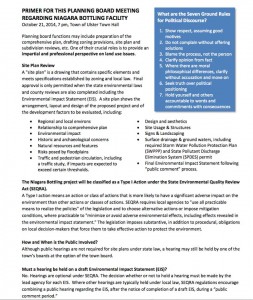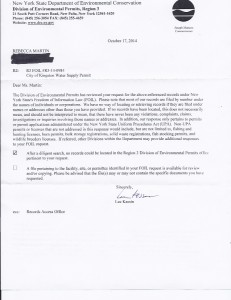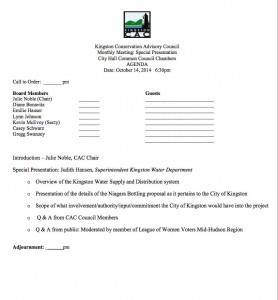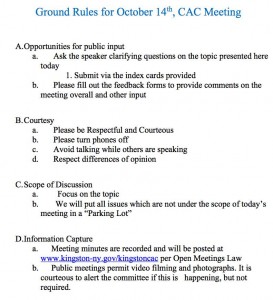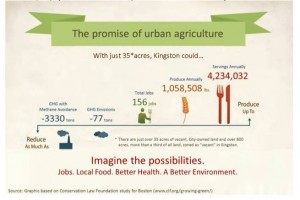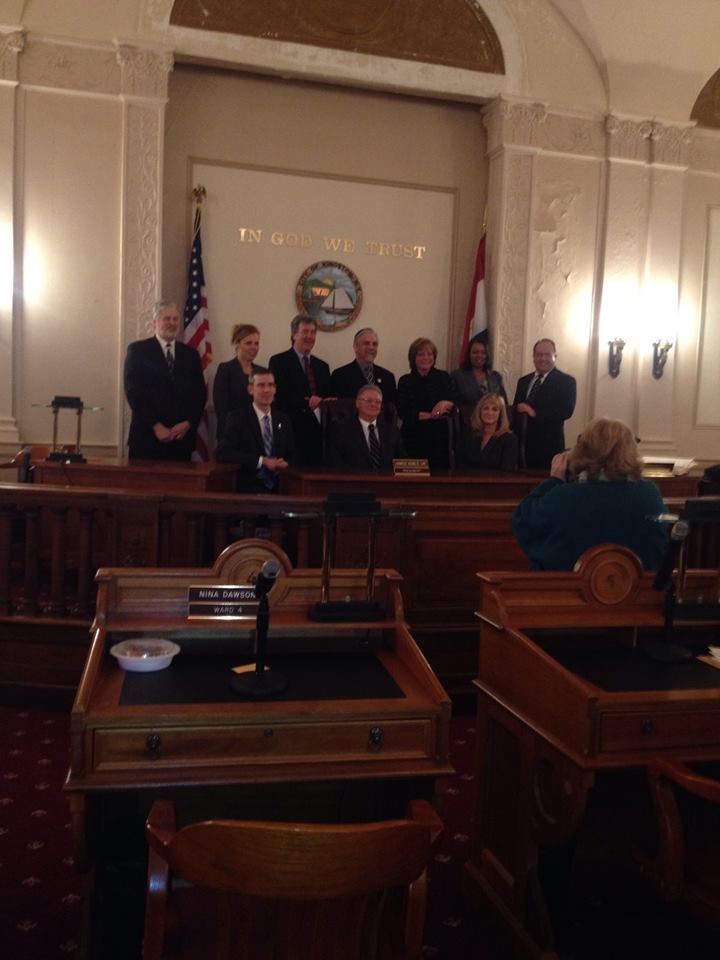Today, we acquired the appointment and terms of the current City of Kingston Water Board Commissioners Appointments and Terms.
Education
Kingston Water Department ‘Will Serve’ Letter Issued on September 15th, 2014
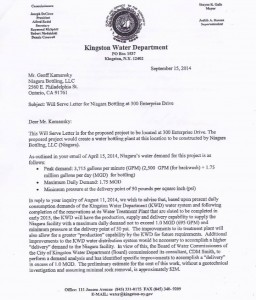
By Rebecca Martin
Today, we received a copy of the the ‘Will Serve’ letter (we had heard others and ourselves had been calling it a ‘Will Share’ letter. The proper term is ‘Will Serve’) issued by the Kingston Water Department to Niagara Bottling, LLC on September 15th, 2014.
It was done the day before Peter Romano of The Chazen Companies gave their presentation to the Town of Ulster Planning Board on September 16th (click on link to listen. Romano’s presentation begins at 1:15:26), 2014. As you recall, the Planning Board that evening agreed to pass ‘Lead Agency’ of the SEQR process along to the Town of Ulster Town Board. A resolution passed on September 18th, 2014 for The Town of Ulster as ‘Lead Agency‘ (click on link to listen. The Town Board discussion on Lead Agency begins at 16:30).
The letter ends by saying “Please let me know if this meets your requirements so that we can execute a more formal agreement that is acceptable to both parties” and “The Board of Water Commissioners looks forward to working with Niagara and welcomes you to the City of Kingston.”
10/21/14: PLANNING BOARD MEETING PRIMER: Town of Ulster Planning Board Meeting regarding Niagara Bottling Facility
By Rebecca Martin
This is a great primer for the Planning Board meeting this evening created by Jennifer Schwartz Berky, a Kingston resident and planning professional. It should help you a great deal in following along.
City of Kingston: Water Supply Permit and Water Supply Applications of 1954 & 1929.
Recently, we reached out to the DEC (Department of Environmental Conservation) to see if we could receive a copy of the most recent Water Supply Permit by the City of Kingston. They asked that we FOIL (NYS’s Freedom of Information Law) for their records, which we did.
WHAT TO EXPECT: October 14th Meeting Hosted by the Kingston Conservation Advisory Council
WHAT
Kingston Conservation Advisory Council: Monthly Meeting/Special Presentation
with Kingston Water Department Superintendent Judy Hansen
WHEN
Tuesday, October 14th
6:30pm
WHERE
Kingston City Hall, Council Chambers
By Rebecca Martin
We are pleased that the Kingston Conservation Advisory Council has quickly organized a meeting to host Kingston Water Department Superintendent Judy Hansen. She will be giving an overview of the Kingston Water Supply and Distribution system, present the details of the Niagara Bottling Proposal as it pertains to the City of Kingston and the scope of what the involvement/authority/commitment the City of Kingston would have into the project.
The League of Women Voters of the Mid Hudson Region will moderate the public Q&A period following the Kingston Conservation Advisory Committee Council members have their own public Q&A period with Hansen. Questions will be requested in writing prior to the meeting.
Below is the agenda and ground rules for the public.
Kingston is fortunate to have a Conservation Advisory Council with many years of environmental experience. The group has sponsored many great INITIATIVES that includes CLIMATE SMART KINGSTON that embraces comprehensive policies and programs for the City of Kingston to reduce greenhouse gas emissions, enhance operational and energy efficiencies, reduce energy costs, support local job growth, and adapt to a changing climate while improving quality of life, saving taxpayer dollars and promoting social justice. It’s a document that Judy Hansen as of Wednesday hadn’t yet read, or distributed to the Water Board.
READ more to learn about the members and their long standing history on environmental matters. City of Kingston employees Gregg Swanzey (Director, Office of Economic Development & Strategic Partnerships) and Julie Noble (Chair, and Environmental Educator) are both members.
KingstonCitizens.org will be filming this meeting.
For more information on this meeting, contact Julie Noble at: JulieLNoble@kingston-ny.gov
Food & Water Watch Testifies at Kingston Common Council Meeting
 Alex Beauchamp is the Northeast Region Director at Food & Water Watch. Based in the Brooklyn office, Alex oversees all organizing efforts in New York and the Northeast. Alex has worked on issues related to fracking, factory farms, genetic engineering, and water privatization at Food & Water Watch since 2009. His background is in legislative campaigning, and community and electoral organizing. Before joining Food & Water Watch, Alex worked for Grassroots Campaigns, Inc., where he worked on several campaigns including organizing support for renewable energy in Colorado, fundraising, and running get-out-the-vote operations. Alex graduated from Carleton College with a degree in political science. He can be reached at abeauchamp(at)fwwatch(org).
Alex Beauchamp is the Northeast Region Director at Food & Water Watch. Based in the Brooklyn office, Alex oversees all organizing efforts in New York and the Northeast. Alex has worked on issues related to fracking, factory farms, genetic engineering, and water privatization at Food & Water Watch since 2009. His background is in legislative campaigning, and community and electoral organizing. Before joining Food & Water Watch, Alex worked for Grassroots Campaigns, Inc., where he worked on several campaigns including organizing support for renewable energy in Colorado, fundraising, and running get-out-the-vote operations. Alex graduated from Carleton College with a degree in political science. He can be reached at abeauchamp(at)fwwatch(org).
Kingston’s Cooper Lake “Safe Yield”. How’d They Come Up With That?
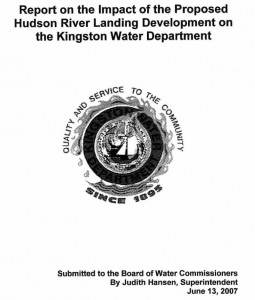
By Rebecca Martin
According to this “Report on the Impact of the Proposed Hudson River Landing Development on Kingston Water Department” created in 2007, it says that “the COK had a daily water usage of 3.28 million GPD (today, it is at 3.5 million GPD) and that at that time our ‘safe or dependable yield’ was 6.1 million GPD.
“By definition, the safe yield of any water supply is the maximum dependable water supply that can be withdrawn continuously from a supply during a period of YEARS (how many?) in which the driest period or period of greatest deficiency in water supply is likely to occur.
For Kingston Water Supply that period CONTINUES TO BE THE DROUGHT OF 1957“
If we are reading this correctly, of note:
1. In 2007, the COK provided 3.28 million GPD on average. Today, that number is at 3.5 million GPD. No matter the size of the increase, it illustrates that our community will grow, as will our needs.
2. The 6.1 million GPD “safe or dependable” yield can be “used for a period of ‘years'”. Though not recommended in this document, if it were ever maxed – for how many years could Cooper Lake sustain? We are hearing that same number today in discussions regarding the Niagara Bottling Co proposal. 6.1 million GPD. Has it not changed in 7 years based on, say – climate change? (the report was written in 2007).
3. The COK Water Department is basing the 6.1 million GPD safe yield number on the drought of 1957. That’s over 50 YEAR AGO.
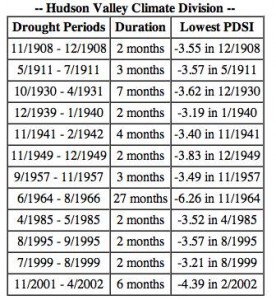
Based on just a little general research – and it all needs to be clarified – the drought of 1957 lasted 3 months. But in 1964 – 1966, a drought in the valley lasted 27 months? What about the 2012 drought? What were rainfall averages in the are from 1950 to today? I’m guessing there is enough data out there for a more current number – and I’d say that it appears that hasn’t been done, and it sure should have been prior to the Kingston Water Department issuing a “Will Share” to the proposed Niagara Project.
Due diligence COK officials.
The Public Trust Doctrine: Protecting Water Resources
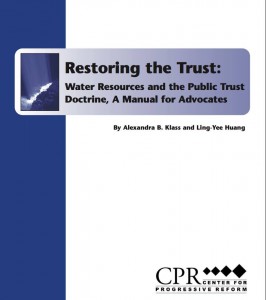
“Much of the battle to preserve and protect water resources happens at the state and local levels – in any number of policy choices advocated and made by individuals, organizations, companies, and governments. In recent years, water activists have begun to deploy a new tool geared to shape these decisions. Long-established in legal jurisprudence, the public trust doctrine holds that certain natural resources belong to all and cannot be privately owned or controlled because of their intrinsic value to each individual and society. While water resources protected under the doctrine may not be monopolized by private entities, they nevertheless face great strains today from private use and misuse.”
READ: The Public Trust Doctrine: Protecting Water Resources
READ: “Restoring the Trust: Water Resources and the Public Trust Doctrine: A Manuel for Advocates”
NEW! READ: “The Mono Lake Case, the Public Trust Doctrine, and the Administrative State”
AUDIO: Niagara Bottling Co. Proposal Presentation for the Town of Ulster
The following is Audio from both the Town of Ulster Planning Board meeting on 9/16/14 and the Town Board meeting on 9/18/14.
Jobs: Urban Agriculture and Niagara Bottling Co.
By Rebecca Martin
Niagara Bottling Co. wants to come to the area (tax free) to bottle and to sell 1.75 million gallons of Kingston City Water (Cooper Lake) per day. The Water may be tax free too. It is unclear whether or not that to be the case at this time.
The City of Kingston’s Water Department has provided a ‘will share’ letter to the project, but has not yet negotiated a rate (probably because they can’t without the Common Council’s permission).
With an estimated 260 trucks per day coming and going out of the site! That’s a lot of trucks.
According to their proposal, ALL FOR 160 JOBS when the facility is working at full capacity.
LOOK HERE. Based on an Urban Agriculture study that was created specifically for Kingston, the City of Kingston has approximately 800 acres of zoned ‘vacant’ land in Kingston. With just 35 acres working for us inside the city, we would create approximately 156 jobs. Kingston is way ahead of the curve on the Urban Ag front in the Hudson Valley, too.
We can do this, Kingston.
READ THE REPORT
ON URBAN AG IN KINGSTON
HOLD THE DATE! “Exploring the Role of Kingston’s Common Council” on May 28th.
We are pleased to announce our next Educational Forum to occur on Wednesday, May 28th at the Kingston Public Library from 6:00pm -8:00pm. Our topic that evening will be: “Exploring the role of Kingston’s Common Council” with special guests Alderman at Large James Noble, Majority Leader Matt Dunn and Minority Leader Deb Brown.
Professional Managers: Good Reads for Educational Panel on City Manager/City Administrator Forms of Government
Please enjoy these links that explain the different aspects and functions of professional management (City Manager/ City Administrator Forms of Government).
1. Supporting Elected Officials
http://lifewellrun.org/professional-managers/supporting-elected-officials/#.UzG51jkQfcM
2. Key Facts about Professional Local Government Managers.
Click to access 12-147-LWR-Key-Fact-Sheet2.pdf
3. Description of five forms of local government in the US.
http://icma.org/en/icma/knowledge_network/documents/kn/Document/9135/Forms_of_Local_Government_Structure
“State of the City Address”. A Mayors Obligation and How Kingston’s City Charter is Similar in Nature to the Constitution.
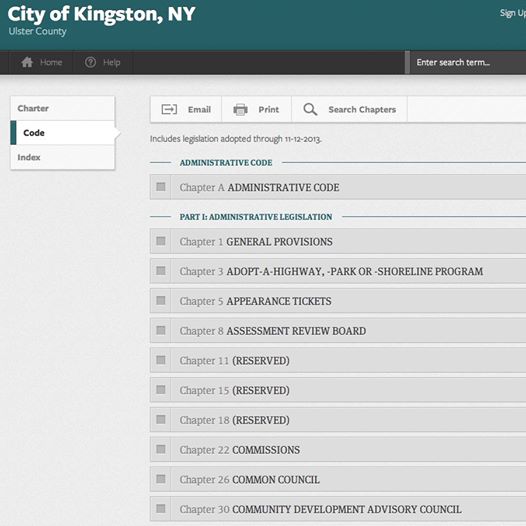
No matter how busy the Mayor’s office is today, a “State of the City” address isn’t an elective. It’s an obligation.
According to the City of Kingston, NY Charter in Article IV: Mayor, Section C4-4 Annual Message it is written that “The Mayor shall prepare and present during the first month of each fiscal year of the City an annual message to the Common Council. The annual message shall describe the condition and state of the city and shall identify matters and issues the Mayor believes should be addressed by the Council in the ensuing year.”
…and no matter how sympathetic to the Mayor one may be (and in all fairness, I am – as I think it’s far too large a job for only one person – hence, my desire to learn more on City Manager/City Administrator Forms of Government), it may not be legal for an elected official to not follow the charter as written. That certainly should be looked into.
Have a look at “Revising City Charters in NY State” and read the introduction and history of this important document. The charter is “the basic document that defines the organization, powers, functions and essential procedures of city government. It is comparable to the State Constitution and to the Constitution of the United States. The charter is, therefore, the most important law of any city“.
###
The city of Kingston’s Common Council, on the other hand, has its own set of rules outside of Kingston’s charter.
The “Council Rules for Government” is a document that is not currently available on the City of Kingston website (as far as I can tell, and it should be accessible to the public in the same way the Chater is). I am happy to have received a copy and to make it public here.
In the way of the “State of the City Address” for council members, have a look at page 48, Rule XVII State of the City Address. For some reason, the council found it sound to require “…unanimous consent of the Majority (and Minority) party, the Majority (and Minority) Leader may deliver a State of the City Address at the regularly scheduled Febraury Common Council meeting each year.”
What does that mean? If one alderman decides to vote ‘no’ (as what did occur last week with Ward 2 Alderman Brian Seche), the entire opportunity for the public to hear from their council majority/minority leaders is thrown out the window?
Maybe now is the time to look closer at these documents. The public should take the time to read and get to know both the charter and the council rules so that it collectively understands how its city works from the inside out.
Here are some suggestions:
1. OUR MAYOR: Write and call the Mayor’s office and request that the law be respected, and that the annual ‘State of the City Address” be delivered.
Mayor Shayne Gallo 845/334-3902 sgallo@kingston-ny.gov
Assistant, Ellen DiFalco
2. MAJORITY/MINORITY LEADERS: Write to both our Majority Leader Matt Dunn (Ward 1) and Minority Leader Deb Brown (Ward 9) in support of their performing a ‘State of the City Address” whether it be official, or unofficial.
Alderman Matt Dunn ward1@kingston-ny.gov
Alderwoman Deb Brown ward9@kingston-ny.gov
3. ALDERMAN-AT-LARGE JIM NOBLE: Write to Alderman-at-Large Jim Noble and ask him to explain the meaning behind the rule that requires a vote for our Majority/Minority leaders to speak to the public annually on the State of the City.
If a vote is necessary, then ask that the council take up the “Council Rules of Government” and change the ‘unanimous’ to ‘majority’.
Given what happened last week, it’s astonishing that one single vote can derail this opportunity for citizens.
– Rebecca Martin
RESOURCES
GET TO KNOW Kingston, NY City Charter READ
GET TO KNOW Revising City Charters in New York State READ
GET TO KNOW The Council Rules of Government READ
MORE ON – Kingston: “Strong Mayor” or “City Manager” Form of Government?
(This piece was originally printed in the Kingston Times in August of 2013 after a flurry of firings at Kingston City Hall in Kingston, NY. This is an edited version).
###
“When you find that change is constant, will you shun complacency?” – J. Harris
As a kid, I grew up in a household of ‘activists.’ That’s what my parents were called anyway. It never occurred to me then, or now, that they were anything out of the ordinary. For is it activism or ones duty to shine the light on a problem that lies inside or out of the community?
In the mill town where I am from, my father was a family doctor and my mother a nurse. Together, the two cared for generations of people who one day began to show up at an alarming rate with both common and also extremely rare types of cancers. Wanting to understand this phenomenon led my parents to the discovery of a dioxin contamination that was produced by the mill. A by-product of the bleaching process in papermaking, it’s a severe carcinogen also found in the notorious Vietnam War defoliant Agent Orange. All day long, they put out a large pool of muddy dioxin-laced sludge right out in the open. Without good management regulations at that time, it was disposed of by being dumped into the rivers, buried on mountaintops and burned close by. The geography of the area made for a noxious smog that hung over the valley like an impending death sentence. But noone listened.
Years later, my hometown was dubbed “Cancer Valley”. You’d think it to be enough to wake even the staunchest of cynics. But it wasn’t. The industry scurried about to downplay the statistics and public officials obliged. “Those damn elitist activists.” they’d say with their heads buried in the sands.
How do you get away with such a thing?
The people’s needs are simple. They want a job to best utilize their skill set, a roof over their head, food on the table and a good education for their children. With jobs scarce in most rural places, a lack of alternatives allow for easy management of a problem like this. Vocal residents were diminished by threats from their large employer to pack up and leave. Residents without options would resort to nostalgia. “Our town will prosper as it always has”. Even as it slowly bled to death.
Now thirty years later, the town that I knew is barely recognizable. The population has aged out. Young families have moved away. Generations no longer generate. It is necessary today for mill workers to be brought in to keep the mill in business with those who haven’t a connection to the history or the spirit that once was. The wealthy are no longer professionals. They are those who have the means to gobble up foreclosed properties to use as Section 8 housing.
A cautionary tale.
I turned out to be an artist. Things that the average person fear are just a part of ordinary life for me – and so that “fearlessness” and then a knack for organizing make for one hell of a tool chest in these times. Four years after moving into this adopted city of mine (and today, I’m a Kingston resident now for 12 years – the longest I’ve lived anywhere else other than my home town) and shortly after becoming a mom, I became what they call a ‘community organizer’ or ‘activist’ I suppose – and what I found was a gaping hole between the people and city hall that was downright disconcerting. Over the years and with the help of many volunteers and good souls, close to 50 initiatives both large and small to help repair that disconnect were created and diligently worked upon that would serve the public for a long time to come. Those of you who have come along for the ride for the past 8 years know what I’m speaking of.
***
I’ve been dismayed by recent events in Kingston. The decisions and reactions of our mayor have disappointed me, but it’s not something I haven’t already seen in one form or another in Kingston’s recent past. On first blush, I find my inner dialogue focused on the politicians short comings. But the truth is, that our collective lack of knowledge and resignation in how local government works is where the problem lies.
Furthermore, the people’s collective acceptance of bad behavior from those working on their behalf is mystifying. With such low expectations, what chance is there to develop and attract a greater range of talent and professionalism in high office elected positions?
Starting from the top down, Kingston has what is known as a “strong mayor” form of government. That means that whoever is elected into office essentially has full administrative authority. The people are encouraged to vote ‘across the line’ (promoting lazy voters in my estimation) and your mayor ends up navigating a $36.8 million dollar budget, a population of about 24,000 people and an entire aging citywide infrastructure.
Here’s the thing. He or she isn’t required to have any specific qualifications for a job like this because qualifications is unconstitutional for any elected official. Did you know that? In essence, that means that anyone at all can be your mayor, whether they are experienced in city management or not. Think about that for a moment and try not to panic.
The city charter currently allows ‘mayor’ to appoint department heads and membership to the city’s internal committees without much or in some cases any oversight. They might choose to cast a net to hire the most qualified candidates locally, or enlist those whose merit lies mainly in having helped them to become elected into office. As we have recently witnessed, the latter approach has led to an unprecedented number of firings.
Take a look sometime at the City of Kingston’s charter and read Article IV: “Mayor “General Powers and Duties.” The executive duties are light at best.
Compare that to municipalities with a City Manager (Oneonta, NY) or City Administrator (Beacon, NY). Pretty astonishing don’t you think?
What would be in the public’s best interest is to have an ongoing community discussion on the choices that exist for how a city like ours could be run.
Twenty years ago for a hot minute Kingston actually had a city manager form of government. It was a hard earned effort that was forged by a group of active citizens with the support of the chamber of commerce. There is an article written by Tom Benton that the Kingston Times published describing how it all came to light. Prior to that, the mayor’s role was considered a full time position, but with only part time pay. More of a role had by a retiree with some clout in the community as I understand it.
City Manager wasn’t long lived here in Kingston – as T.R. Gallo, who petitioned at the last minute to reverse the ‘City Manager’ outcome before he himself ran for mayor, strengthening its role to what it is today.
If set up correctly, a city manager could diminish the power of party politics by placing more responsibility on a larger body of elected officials and therefore, placing more control in the hands of the people.
I like that.
How about requiring those newly elected council members to take a course in civics and in Kingston government? (new school board trustees get mandatory training.) Furthermore for our council, what about term limits with a maximum of two terms? It should be a common man’s position. Like jury duty. There is no better way to learn how your local government works than by landing a role in it for a short time. If you find that you have a knack for public service? Run for higher office.
Kingston is in the midst of rewriting its citywide Comprehensive Plan, a process that hasn’t been undertaken since 1961. They are calling it “Kingston 2025” and it’s meant to act as a road map for creating a resilient and sustainable community over the next 12 years. That’s entirely possible given the efforts of a good number of initiatives that have been underway for some time. Kingston citizens, get in there. Give your input and ask that once the new plan is in place, that it is looked at again for proper updates under each new executive office term. That’s every four to five years.
City government is ours and as soon as we are afraid of it, we no longer live in a democracy. What is necessary to make things run smoothly in todays climate is organization, cooperation and different points of view. Be inquisitive, stay current and together make the changes that are needed and available to us.
– Rebecca Martin
How Kingston Got It’s “Strong Mayor” Form of Government.
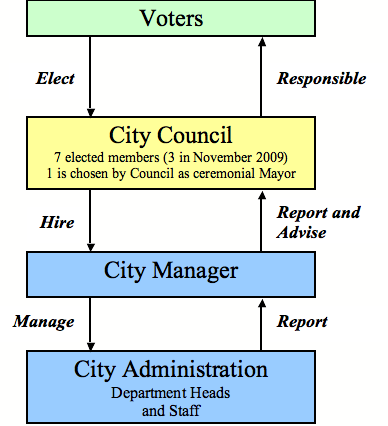
Did you know that in 1993, the City of Kingston adopted (by a landslide) a City Manager form of government? This is a great old article that helps us to understand what happened back then and also how we ended up with a strong mayor form of government.
Thanks to Tom Benton and Ulster Publishing for allowing us to repost this article.
How Kingston got its ‘strong mayor’
Commentary by Tom Benton
(originally printed in the KINGSTON TIMES)
This is how it actually went down, nearly 20 years ago. I should know; I was there. In fact, in a way I was caught up right in the middle of it all, though that was not my intention.
Some time around 1992, Kingston Mayor John Amarello got to thinking that the city’s charter, which hadn’t been modified since the late 1800s, could use a little updating. Maybe it was those provisions prohibiting displays of magic and legerdemain (sleight of hand) on city streets that got him thinking, or the ones dealing with where horses could be tied up. In any event, the mayor decided that it would be useful for someone to take a look at the charter to see if some modernizing might be in order.
And so it was that he decided to create a Charter Revision Commission to tackle the task. John — I knew him well enough to call him by his first name — approached me about acting as chairman of the committee. At the time, I was a young attorney practicing in Kingston, very much involved with various civic groups and friendly with many of the business and governmental figures in town. And best of all from the mayor’s standpoint (or so I believe now), I had no political axe to grind. I have never sought or held elective office (unless you count student council in high school) and had no aspirations to do so then. So I think the mayor felt that I would be somewhat free from the rough-and-tumble of local, partisan politics. If I may say so, they don’t get more fractious anywhere than they do in Kingston (with the possible exception of the recent debt ceiling imbroglio in Washington).
With some reservations about the time commitment it would involve, I signed on, so to speak, along with a half-dozen or so other local appointees. Significantly, one of those original members was then-Alderman T. R. Gallo, who resigned from the commission after several meetings (more about that later). We set about our work at frequent evening sessions, studying the charter of Kingston along with those of other similarly sized small cities. As it happened, I was also then the president of the board of directors of the Ulster County Chamber of Commerce. Some chamber members I knew believed that the “city manager” form of local government was preferable to the traditional model, theoretically being more efficient and business-like, and they encouraged me to introduce that concept into our discussions.
A brief overview of the “city manager” form: Traditionally in the U.S., most governments, be they state, county, city, village or town, have followed the federal model, wherein three branches (executive, legislative and judicial) regulate the entity’s affairs. This structure is designed to provide checks and balances on the uses and potential abuses of power. By the beginning of the 20th century, progressives started to wonder whether all that power-balancing was really needed at the smaller and more local levels of government. Couldn’t the legislative body (city council) just hire an executive to conduct the administrative affairs of the community? After all, the council has its own internal checks and balances built in by virtue of its multiple members. It was also thought a hired executive, with specific training and expertise, would provide better and more efficient operation than might be expected from an elected mayor who, well-liked and popular though he or she might be, usually has no real training for the job.
I don’t remember the number of meetings we had, but in the course of many weeks, a consensus began to build in the direction of the “city manager” form. I believe that this was about the time Mr. Gallo bowed out. Be that as it may, after months of meetings and many hours of discussion and debate, the commission ultimately finalized a proposed revised charter for the City of Kingston, incorporating the city manager concept. This was submitted to the city for consideration and potential adoption.
During the spring and summer of 1993, the charter revision commission held a number of public information meetings throughout the city, so residents would have the opportunity to learn about the new proposal. These were well-attended and aroused great interest and passion on both sides. In due course, and in accordance with the required procedure, Kingston’s Common Council approved the submission of the proposed charter revision to the local board of elections so that it could be placed on the ballot as a referendum item to be voted on in the fall of 1993. Supporters of the measure conducted an aggressive grass-roots campaign, handing out flyers door-to-door in Kingston neighborhoods and taking out ads in local newspapers. On Election Day, the revision was approved.
Those of us who had been active in the revision process, including prominent local business figures like Frank Bailey, George Hutton, George Bell and others, were celebratory. But it should be admitted that there was no certainty about how well the “city manager” form of government would work in Kingston. The “city manager” form had been quite successful in some cities — Austin, Texas, for example — but arguably less so in others. And the work of transition still lay ahead, as the new charter structure was to take effect in January 1995.
As it happened, the 1993 vote also brought about the defeat of the incumbent Republican mayor, John Amarello, by the Democratic candidate, T.R. Gallo. It was no secret that T.R. had long dreamed of becoming Kingston’s mayor. His late father was a fixture in Kingston politics two decades earlier. The new charter preserved the office of mayor, but significantly reduced his or her official duties and authority to what might fairly be characterized as “ribbon-cutter in chief.” This was far from what the newly elected mayor had envisioned for himself.
After a few weeks, then-alderman-at-large, James Sottile, responsibly formed an ad hoc committee to work on the transition process and to begin the search for a city manager. Because of my past involvement with the new charter, I was invited to participate in that group as a citizen member at meetings throughout the winter of 1993-94. Some time in the spring, word began circulating in Kingston about a new proposal which would supplant the recently adopted city manager charter by providing for a so-called “strong mayor” — an elected mayor with greater authority than is traditionally found. The document itself soon surfaced as Mayor Gallo began a public petition campaign to place the new charter revision proposal on the 1994 ballot as a referendum item.
To place a referendum on the ballot (an alternative to the mayoral commission procedure) requires the signatures of certain percentage of the affected voting public. Even for a mayor as popular as T.R. Gallo, this was a large undertaking, particularly in the turbulent wake of the previous year and a half of charter debates. As for the proposal itself, it was rather ingeniously constructed by taking the newly adopted charter and merely replacing the words “city manager” with “mayor” throughout. There were some other modifications, of course, but that was the essence of it. And here was the effect: Under the adopted charter, the city manager was given very broad and powerful executive authority, the governmental check on that authority being control and supervision by the Common Council. Under the new proposal, an elected mayor would have the same broad authority, but would be entirely free from any such control or supervision by the council. Strong mayor, indeed!
By late August, it appeared that the petition campaign would fall short of the required number of signatures. With time was running out to meet the filing deadline for the fall vote, Mayor Gallo hastily created a his own charter revision commission, whose appointed members immediately adopted the new “strong mayor” proposal without discussion or debate. A single public information meeting (a half-hour in duration) was held a few days later at City Hall and in short order, the “strong mayor” charter was submitted to the board of elections for placement on the ballot. As I recall, all of this took place in the space of less than two weeks.
With Election Day looming, there ensued an intense period of public debate and a visible war of lawn signs. Things took a turn toward the uncivil. At a public information meeting sponsored by The League of Women Voters, I was loudly and aggressively heckled throughout my presentation by a small group of partisans. Such was the tone and tenor of the time.
Many Kingstonians will remember the outcome. In one of the largest voter turnouts in city history, the “strong mayor” charter revision was passed into law. Although the margin of victory was narrow (around a hundred votes, as I recollect), the city manager charter adopted a year earlier was consigned to history without ever having been tried and the era of the strong mayor was ushered in.
Disappointed as some of us were, we all moved on. But the city manager issue has recently resurfaced in comments by some Kingston mayoral candidates. Knowledge of historical precedent can be instructive, so perhaps the foregoing will be useful to some. For others, it might merely be an interesting story. I do note that the county has recently changed to an “executive” structure. If Kingston does decide to revisit the city manager concept, it is hoped that the residents display the political will to give it a fair chance the second time around.
Tom Benton is a retired attorney who owns and operates the Tom Benton School of Music in Woodstock.

